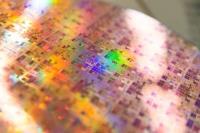 Add My Company
Add My Company
Sign In

CEA-Leti, a French technology research institute of the CEA and Inac, a joint fundamental research institute between the CEA and the University Grenoble Alpes, today announced a breakthrough towards large-scale fabrication of quantum bits, or qubits, the elementary bricks of future quantum processors. They demonstrated on a 300 mm pre-industrial platform a new level of isotopic purification in a film deposited by chemical vapor deposition (CVD). This enables creating qubits in thin layers of silicon using a very high purity silicon isotope, 28Si, which produces a crystalline quality comparable to thin films usually made of natural silicon.
“Using the isotope 28Si instead of natural silicon is crucial for the optimization of the fidelity of the silicon spin qubit,” said Marc Sanquer, a research director at Inac. “The fidelity of the spin qubit is limited to small values by the presence of nuclear spins in natural silicon. But spin qubit fidelity is greatly enhanced by using 28Si, which has zero nuclear spin. We expect to confirm this with qubits fabricated in a pre-industrial CMOS platform at CEA-Leti.”
Qubits are the building blocks of quantum information. They can be made in a broad variety of material systems, but when it comes to the crucial issue of large-scale integration, the range of possible choices narrows significantly. Silicon spin qubits have a small size and are compatible with CMOS technology. They therefore present advantages for large-scale integration compared to other types of qubits.
Since 2012, when the first qubits that relied on electron spins were reported, the introduction of isotopically purified 28Si has led to significant enhancement of the spin coherence time. The longer spin coherence lasts, the better the fidelity of the quantum operations.
Quantum effects are essential to understanding how basic silicon micro-components work, but the most interesting quantum effects, such as superposition and entanglement, are not used in circuits. The CEA-Leti and Inac results showed that these effects can be implemented in CMOS transistors operated at low temperature.
CEA-Leti and Inac previously reported preliminary steps for demonstrating a qubit in a process utilizing a natural silicon-on-insulator (SOI) 300 mm CMOS platform1. The qubit is an electrically controlled spin carried by a single hole in a SOI transistor. In a paper published in npj Quantum Information2., CEA-Leti and Inac reported that an electron spin in a SOI transistor can also be manipulated by pure electrical signals, which enable fast and scalable spin qubits.
“To progress towards a practical and useful quantum processor, it is now essential to scale up the qubit,” said Louis Hutin, a research engineer in CEA-Leti’s Silicon Components Division. “This development will have to address variability, reproducibility and electrostatic control quality for elementary quantum bricks, as is done routinely for standard microprocessors.”
To help CEA-Leti and Inac leverage nuclear spin free silicon in the CMOS platform, a silicon precursor was supplied by Air Liquide, using an isotopically purified silane of very high isotopic purity with a 29Si isotope content of less than 0.00250 percent, prepared by the Institute of Chemistry of High-Purity Substances at the Russian Academy of Sciences. The 29Si isotope is present at 4.67 percent in natural silicon and is the only stable isotope of silicon that carries a nuclear spin limiting the qubit coherence time.
A secondary ion mass spectrometry (SIMS) analysis done on the CVD-grown layer using this purified silane precursor showed 29Si concentration less than 0.006 percent, and 30Si less than 0.002 percent, while 28Si concentration was more than 99.992 percent. These unprecedented levels of isotopic purification for a CVD-grown epilayer on 300 mm substrates are associated with surfaces that are smooth at the atomic scale, as verified by atomic force microscopy (AFM), haze and X-ray reflectometry measurements.
Leveraging their scientific and technological expertise, and the specific opportunities associated with the 300 mm silicon platform on the Minatec campus, CEA-Leti and Inac will continue to contribute to the scientific, technological and industrial dynamic on quantum technologies, enhanced by the implementation of the EC’s FET Flagships initiative in this domain.
1. “A CMOS silicon spin qubit”, arXiv:1605.07599 Nature Communications 7, Article number: 13575 (2016) doi:10.1038/ncomms13575
2. “Electrically driven electron spin resonance mediated by spin-valley-orbit coupling in a silicon quantum dot”, Nature PJ Quantum Information (2018) 4:6; doi:10.1038/s41534-018-0059-1
For more information on CEA SHOWS PATH TO CREATING BUILDING BLOCKS OF QUANTUM PROCESSORS WITH 28Si ISOTOPE IN A CMOS FAB LINE talk to Whats New in Electronics (WNIE)
Enquire Now
More News
List your company on FindTheNeedle.

